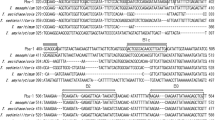Abstract:
A rapid method, utilizing both polymerase chain reaction (PCR) and enzyme-linked immunosorbent assay (ELISA), was developed for detection of oyster MSX disease. The technique included using Haplosporidium nelsoni pathogen-specific PCR primers (based on ribosomal RNA genes), a Chelex resin (for rapid DNA extraction from oyster mantle tissues), and cloned H. nelsoni rRNA plasmid DNA (for use as a capture probe). Digoxigenin was incorporated into the pathogen-specific PCR products, which were captured by the coated probe in a fast hybridization reaction and then detected by ELISA. The sensitivity of PCR amplification on cloned plasmid DNA was 10 fg for detection by stained agarose gel, and increased to 0.01 fg for ELISA. Positive signals were observed in infected oysters using the PCR-ELISA technique. This method may be applicable to early detection of infection.
Similar content being viewed by others
Author information
Authors and Affiliations
Additional information
Received April 14, 1998; accepted September 30, 1998.
Rights and permissions
About this article
Cite this article
Ko, YT., Chan, MY., Ford, S. et al. A PCR-ELISA Method for Direct Detection of the Oyster Pathogen Haplosporidium nelsoni . Mar. Biotechnol. 1, 147–154 (1999). https://doi.org/10.1007/PL00011762
Issue Date:
DOI: https://doi.org/10.1007/PL00011762




